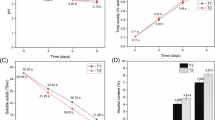Abstract
Alicyclobacillus acidoterrestris is a thermoacidophilic, non-pathogenic, spore-forming bacterium detected in spoiled commercial pasteurized fruit juice. Apple, white grape and tomato are particularly susceptible. A. acidoterrestris spores are resistant to lemon juice pasteurization (2 min at 82°C), and they can germinate and grow causing spoilage. This contamination is characterized by a medicinal or disinfectant smell attributed to guaiacol (o-dihydroxybenzene) production and other taint chemicals. The aim of this work was to study the influence of temperature (82, 86, 92 and 95 °C), total soluble solids (SS) (6.20, 9.8, 50 and 68°Brix) and pH (2.28, 2.45, 2.80, 3.25, 3.5) on decimal reduction time (D) of the A. acidoterrestris in clarified and non-clarified concentrated lemon juice. Once D-value was determined, the resistance of A. acidoterrestris at the assayed temperatures was confirmed. SS and pH influence spore viability, because spore resistance increases with higher SS (50°Brix 22 min 82 °C–68°Brix 28 min 82 °C) and pH values (pH 2.28, 17 min–pH 4.00, 22 min). Bacterial growth was lower in clarified lemon juice, 26 min at 82 °C, than in non-clarified lemon juice, 51 min at 82 °C. Temperature was the parameter that had the greatest influence on the D value.


Similar content being viewed by others
References
Gocmen D, Elston A, Williams T, Parish M, Rouseff RL (2005) Identification of medicinal off-flavours generated by Alicyclobacillus species in orange juice using GC-olfactometry and GC-MS. Lett Appl Microbiol 40:173–177
Jensen N, Whitfield FB (2003) Role of Alicyclobacillus acidoterrestris in the development of a disinfectant taint in shelf-stable fruit juice. Lett Appl Microbiol 36:9–14
McIntyre S, Ikawa JY, Parkinson N, Haglund J, Lee J (1995) Characteristics of an acidophilic Bacillus strain isolated from shelf-stable juices. J Food Protect 58(3):319–321
Murray M, Gurtler J, Ryu J, Harrison M, Beuchat L (2007) Evaluation of direct plating methods to enumerate Alicyclobacillus in beverages. Int J Food Microbiol 115(1):59–69
Orr RV, Shewfelt RL, Huang CJ, Tefera S, Beuchat LR (2000) Detection of guaiacol produced by Alicyclobacillus acidoterrestris in apple juice by sensory and chromatographic analyses, and comparison with spore and vegetative cell populations. J Food Protect 11:1517–1522
Pettipher GL, Osmundson ME, Murphy JM (1997) Methods for the detection and enumeration of Alicyclobacillus acidoterrestris and investigation of growth and production of taint in fruit juice and fruit juice-containing drinks. Lett Appl Microbiol 24:185–189
Pontius AJ, Rushing JE, Foegeding PM (1998) Heat resistance of Alicyclobacillus acidoterrestris spores as affected by various pH values and organic acids. J Food Protect 61(1):41–46
Silva FM, Gibbs P, Vieira MC, Silva CLM (1999) Thermal inactivation of Alicyclobacillus acidoterrestris spores under different temperature, soluble solids and pH conditions for the design of fruit processes. Int J Food Microbiol 51:95–103
Splittstoesser DF, Lee CY, Churey JJ (1998) Control of Alicyclobacillus in the juice industry. Dairy Food Environ Sanit 8(9):585–587
Splittstoesser DF, Churey JJ, Lee CY (1994) Growth characteristics of aciduric sporeforming bacilli isolated from fruit juices. J Food Protect 57(12):1080–1083
Walls I, Chuyate R (1998) Alicyclobacillus historical perspective and preliminary characterization study. Dairy Food Environ Sanit 18(1):1–5
Wisotzkey JD, Jurtshuk P, Fox GE, Deinhard G, Poralla K (1992) Comparative sequence analysis on the 16S rRNA (rDNA) of Bacillus acidocaldarius, Bacillus acidoterrestris, and Bacillus cycloheptanicus and proposal for creation of a new genus, Alicyclobacillus gen.nov. Int J Syst Bacteriol 42(2):263–269
Author information
Authors and Affiliations
Corresponding author
Rights and permissions
About this article
Cite this article
Maldonado, M.C., Belfiore, C. & Navarro, A.R. Temperature, soluble solids and pH effect on Alicyclobacillus acidoterrestris viability in lemon juice concentrate. J Ind Microbiol Biotechnol 35, 141–144 (2008). https://doi.org/10.1007/s10295-007-0276-7
Received:
Accepted:
Published:
Issue Date:
DOI: https://doi.org/10.1007/s10295-007-0276-7




